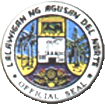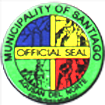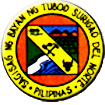
Palencia explains the Eco-Sep technology during the inauguration of the Eco-Sep installation in Lake Mainit in Kitcharao, Agusan del Norte, on July 24. (Story & photos by Jonathan L. Mayuga)
Pollution, brought by poor solid waste management, and inadequate or lack of sewerage and sewage treatment plants (STPs) in the country’s ecotourism sites, pose serious problems on the environment and the health and well-being of the communities.
One such tourism site threatened by the booming ecotourism industry in Mindanao is Lake Mainit, the country’s fourth largest lake and the deepest in the country.
Located in the northeastern section of Mindanao and shared between the provinces of Surigao del Norte and Agusan del Norte, it has a surface area of 173.40 square kilometers and depth reaching 223 meters.
It is bordered by the towns of Mainit and Alegria in Surigao del Norte and the towns of Jabona and Kitcharao in Agusan del Norte.
Key biodiversity area
The lake and its surrounding watershed are considered key biodiversity areas. Lake Mainit’s watershed is the habitat of rare fish species, including puyo, or climbing perch, and gabot, a riverine fish that is said to be on the brink of extinction because of, among others, predation by introduced species.
The forests around the lake are home to rare and threatened wildlife, as well, giving the lake and its surrounding area a high ecological value.
It has been proposed to declare the Lake Mainit watershed as a protected area under the National Integrated Protected Area System.
Economically important
Besides being the source of livelihood of hundreds of families living around it, Lake Mainit is also a source of water essential for household use, as well as irrigation.
It is known in the region for its rich fish resources. More than 30 barangays in the four towns bordering the lake are dependent on it’s bounty for food and livelihood.
With its attractions, Lake Mainit is fast-becoming a popular ecotourism site in the Caraga region, posing serious challenges in promoting sustainable tourism while protecting and conserving the lake’s environment and natural resources at the same time.
DOST solution
In response to the challenge, the Department of Science and Technology (DOST) has developed a technology that will mitigate water pollution that could protect and save important bodies of water, such as Lake Mainit, from human pressure.
Dr. Merlinda A. Palencia, a professor at Adamson University, invented the Eco-Sep technology through funding from Philippine Council for Industry, Energy and Emerging Technology Research and Development (PCIEERD) of the DOST.
The project, “Eco-friendly Septic System for Tourism and Environmentally Compromised Areas,” may yet solve the environmental problems brought about by the direct discharge of untreated wastewater that leaks into the freshwater resources, like lakes and rivers.
Last July 24, the DOST inaugurated the Eco-Sep in Kitcharao, Agusan del Norte, at the town’s newly constructed convention center near Lake Mainit, in its bid to mitigate water pollution.
The convention center is one of several facilities constructed in what will soon be the town’s eco-park to promote Lake Mainit as a tourism site, and to help protect and conserve the lake and the various wildlife that thrive within the surrounding watershed.
Eco-Sep Technology
Eco-Sep will help address the treatment of sewerage and wastewater from households, resorts, hotels and public establishments.
It is a water-treatment system consisting of a plastic septic tank, organomineral and drain field.
The system makes use of filtration and bioremediation which can remove total suspended solids, biochemical oxygen demand and some pathogens.
Natural water treatment
She said Eco-Sep is boosted by the use of vigormin natural water treatment minerals, which she developed. It is natural, odor-free, safe and effective. It neutralizes strong odor, is nontoxic or has no health hazards.
The combination of Eco-Sep and Vigormin can effectively reduce odor in septic tanks and improve septic water quality.
Vigormin, a powder-like substance, is mixed and dissolved in water, which will be poured inside the Eco-Sep tank. It has a resealable outlet that leads to the four-chambered plastic septic tank, allowing the natural water-treatment minerals to do its thing.
So far Eco-Sep has been used in General Luna Public Market, the Traveller’s Beach Resort and General Luna National High School, all on Siargao Island in Surigao del Norte.
Other applications
Vigormin can also be used as an odor neutralizer for decaying organic waste, materials-recovery facilities and landfills.
According to Palencia, the discharge from the system has been found to pass the water-quality standards under the Philippine Water Act. This means the discharge water is safe and can be reused for watering plants or vegetable gardens.
“It will help improve and sustain ecotourism in the country. We all know that the Philippines is one of the top ecotourism destinations all over the world. Caraga is blessed with beautiful islands and white-sand beaches. But pollution is a problem. In Manila, the government launched the Manila Bay rehabilitation program because of pollution,” she said.
According to Palencia, the use of Eco-Sep in Lake Mainit can prevent future problems—mainly water pollution that can undermine the productivity of precious economic resources—whether as water for domestic use, for agriculture or livestock, including ecotourism value.
She said the technology can be used to save lake and rivers, especially in tourism sites where people flock.
“Without a septic tank, the household wastewater goes directly into the lakes or rivers. So does the water from restaurants and resorts near it,” she said.
This, Palencia said, spells problems, as water pollution can compromise valuable freshwater resource which is now being experienced in various parts of the country.
“In 2025, we will have a severe freshwater shortage. Because we have limited freshwater resources and we are polluting and abusing our pristine water resources. Deep wells can no longer be used in Metro Manila, Central Visayas and Southern Tagalog Region. [Because] there are too many people [and because of] improper solid waste management and poor sewerage system. Wastewater? Eighty-five percent are domestic from households and small-scale industries,” she said.
Most water treatment technologies, she said, are capital intensive, because of the design and the technology used.
“The Eco-Sep technology is a low-cost, easily deployable method and mitigates water pollution. You will not spend more than P200 a month for a small household,” she said.
According to Palencia, the Eco-Sep can be modified to enhance its capacity and lengthen its life span from 10 years to 50 years, depending on the materials used. But the magic lies on the special minerals, which she discovered and developed as a natural water treatment mineral to neutralize odor in water.




























